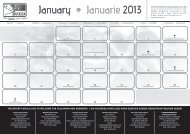Breed Standards - Sussex Cattle Breeders Society
Breed Standards - Sussex Cattle Breeders Society
Breed Standards - Sussex Cattle Breeders Society
Create successful ePaper yourself
Turn your PDF publications into a flip-book with our unique Google optimized e-Paper software.
selection has three results: naturally it<br />
decreases the variation of the present<br />
population, but it has no notable effect<br />
on the variation of the next generation<br />
and it prevents a change of the<br />
average.<br />
More often, however, selection is aimed<br />
at a higher or lower value, for example<br />
for bigger or smaller animals. This<br />
results in displacement of the<br />
population averages, but again the<br />
variation is seldom notably influenced.<br />
The differences between the best and<br />
the poorest remain about the same, but<br />
both groups continue to improve. It is<br />
simply not possible to get all the<br />
animals of a large stude to be equally<br />
as good. Inherently they differ from<br />
each other and for this very reason<br />
sexually reproductive populations ar so<br />
pliable and therefore susceptible to<br />
selection. For this reason the<br />
Simmentaler in Germany could be<br />
selected as a dual purposed breed,<br />
while the same breed is primarily a beef<br />
breed in Australia.<br />
There are no short cut magic formulas<br />
to change the genetic composition of a<br />
breed overnight (except, of course,<br />
through crossbreeding with another<br />
breed). It is a question of continuous<br />
selection pressure with a firm objective<br />
in mind. One or two percent progress<br />
in a year is the best one can hope for in<br />
the majority of cases. This is why it is<br />
so important to limit mistakes to the<br />
minimum. Firstly, and perhaps most<br />
important, with regard to objectives, but<br />
of course also as far as selection itself<br />
is concerned.<br />
17<br />
Objectives<br />
One of the most difficult aspects in<br />
animal breeding is to formulate clearly<br />
outlined breeding objectives. Consider<br />
the changing needs of the market; the<br />
diversity of conditions in which the<br />
same breed must produce the lack of<br />
knowledge on exactly what the breed<br />
originally looked like; and where one’s<br />
physiological limits are, then one can<br />
understand why breeding objectives<br />
are vaguely formulated in terms of<br />
breed standards. <strong>Breed</strong> standards, in<br />
the case of older breeds, are in many<br />
respects a description of the breeding<br />
progress already achieved. One<br />
should expect in these cases that breed<br />
societies should rather entertain the<br />
view that the vast majority of their<br />
animals conform to the breed standards<br />
at any rate, and that the differences<br />
that do occur are very natural and will<br />
always be there if the population<br />
reproduces sexually (in contract with,<br />
for example, cloning). Instead of being<br />
possessed by ideas of breed<br />
standards, such a bred society should<br />
incessantly propagate the strong<br />
aspects of its own breed, while the<br />
breeder asks himself: in respect of<br />
which traits should my breed be<br />
improved further, and selection should<br />
then be aimed primarily at those traits.<br />
The major function of the stud breeder<br />
is to provide bulls to the conventional<br />
producer. The bulls that he provides<br />
should, however, possess certain<br />
characteristics and it is firstly important<br />
for the breeder to formulate these<br />
characteristics clearly for himself and<br />
then strive for them consistently. When<br />
establishing objectives, three factors<br />
should be borne in mind: the objectives




